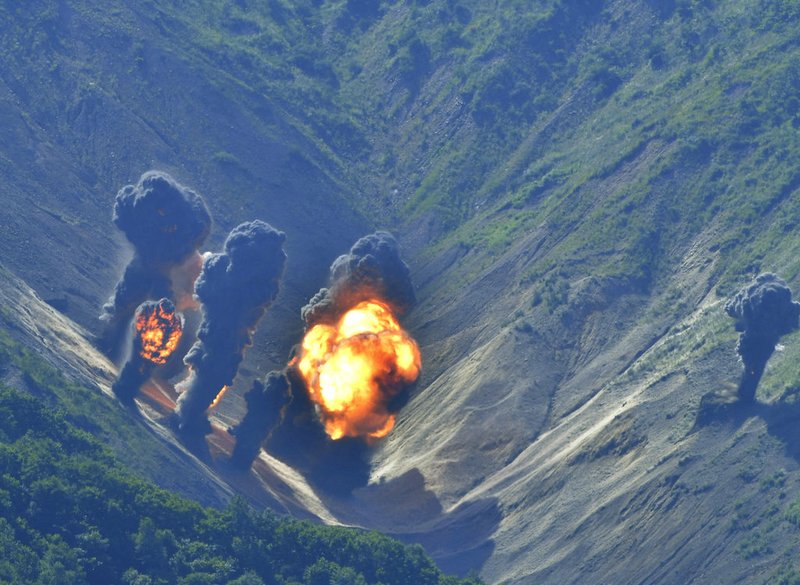SEOUL, South Korea — The United States flew some of its most advanced warplanes in bombing drills with ally South Korea on Thursday, a warning after North Korea launched a midrange ballistic missile designed to carry nuclear bombs over Japan earlier this week, the U.S. and South Korean militaries said.
Two U.S. B-1B supersonic bombers and four F-35B stealth fighter jets joined four South Korean F-15 fighters in live-fire exercises at a military field in eastern South Korea that simulated precision strikes against the North's "core facilities," according to the U.S. Pacific Command and South Korea's Defense Ministry. The B-1Bs were flown in from Andersen Air Force Base in Guam while the F-35Bs came from a U.S. base in Iwakuni, Japan.
North Korea, which claims Washington has long threatened it by flaunting the powerful U.S. nuclear arsenal, describes the long-range B-1Bs as "nuclear strategic bombers" although the United States no longer arms them with nuclear weapons.
Hours after the announcements by Washington and Seoul, North Korea's official Korean Central News Agency issued a short statement calling the exercises a "rash act of those taken aback" by North Korea's recent missile launch.
North Korea has made it clear that it sees its weapons program, which demands regular testing to perfect, as the only way to contest decades of U.S. hostility, by which it means the huge U.S. military presence in South Korea, Japan and the Pacific. Washington, in turn, seeks with its joint drills with Seoul and bomber flights to show that it will not be pushed from its traditional role of supremacy in the region. More missile tests, more bomber flyovers and three angry armies facing each other across the world's most heavily armed border raises the possibility that a miscalculation could lead to real fighting.
The U.S. Pacific Command said the exercises were conducted in response to North Korea's recent missile launch. Over the course of a 10-hour mission, the B-1Bs, F-35Bs and two Japanese F-15 fighters first flew together over waters near Kyushu, Japan. The U.S. and South Korean warplanes then flew across the Korean Peninsula and participated in the live-fire training before returning to their respective home stations, according to the Pacific Command.
"North Korea's actions are a threat to our allies, partners and homeland, and their destabilizing actions will be met accordingly," Gen. Terrence J. O'Shaughnessy, commander of the U.S. Pacific Air Forces, said in a statement. "This complex mission clearly demonstrates our solidarity with our allies and underscores the broadening cooperation to defend against this common regional threat. Our forward-deployed force will be the first to the fight, ready to deliver a lethal response at a moment's notice if our nation calls."
In Beijing, North Korea's ally China warned that war is not an option in finding a solution to the North's growing nuclear capabilities.
Defense Ministry spokesman Col. Ren Guoqiang told reporters that all parties should exercise restraint and avoid words and actions that escalate tension.
The bombing exercise came as the United States and South Korea wrapped up their annual Ulchi Freedom Guardian joint military drills that involved tens of thousands of soldiers. North Korea condemns the annual U.S.-South Korea war games as rehearsals for an invasion and described Tuesday's missile launch over Japan as a response to the drills. Washington and Seoul faced calls to postpone or downsize this year's drills.
The United States often sends its warplanes to South Korea, mostly for patrols, when animosity rises on the Korean Peninsula, which is technically in a state of war because the 1950-53 Korean War ended with an armistice, not a peace treaty.
North Korea on Tuesday flew a potentially nuclear-capable Hwasong-12 intermediate range missile over northern Japan and later called it a "meaningful prelude" to containing the U.S. territory of Guam. North Korean leader Kim Jong Un said the launch was a "curtain-raiser of its resolute countermeasures" against the U.S.-South Korea war games and called for his military to conduct more ballistic missile launches targeting the Pacific Ocean.
Read Friday's Arkansas Democrat-Gazette for full details.
